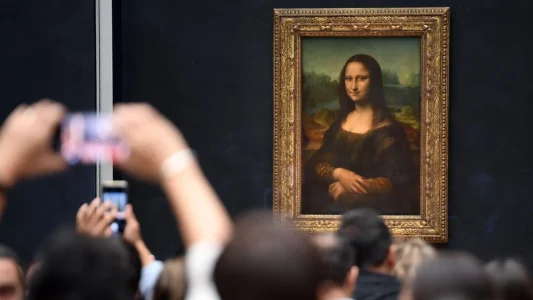Walk into the Louvre Museum in Paris, and you’ll find a perpetual crowd surrounding a single, modestly-sized portrait behind bulletproof glass: Leonardo da Vinci’s Mona Lisa. At just 30 x 21 inches, the painting is smaller than a TV screen. But its cultural weight is immeasurable — and if it were ever sold (which it almost certainly never will be), art experts estimate its value would reach well over $850 million, possibly even surpassing a billion.
So, why does the Mona Lisa cost so much?
To answer that, we must unravel a complex mix of artistic genius, historical mystique, cultural relevance, and pure mythology.
1. The Artist Behind the Masterpiece
First and foremost, the Mona Lisa was painted by Leonardo da Vinci, one of the greatest polymaths in history. His reputation alone elevates the painting’s value. Leonardo wasn’t just a painter — he was a scientist, engineer, and philosopher whose thinking was far ahead of his time.
The painting was created over several years, starting around 1503, and Leonardo kept it with him until his death in 1519. Unlike most commissioned portraits of the time, the Mona Lisa was never delivered to a client. That adds an unusual level of personal significance to the piece.
The artist’s legacy is priceless.
In the world of art, provenance — or the record of ownership and origin — matters greatly. When that origin traces back to a man whose notebooks redefined human anatomy and engineering, the value is no longer just financial; it’s intellectual and historical.
2. The Technique and Innovation
From a technical standpoint, the Mona Lisa was revolutionary. Da Vinci used a technique called sfumato, a method of blending colors and tones so subtly that transitions are almost imperceptible. This gave the painting its haunting realism — particularly in the eyes and enigmatic smile that have baffled and mesmerized viewers for centuries.
The lighting, the natural background, the three-quarter pose — all of it was radical for the early 1500s. The composition became a template for future portraiture.
You’re not just looking at a painting — you’re looking at a turning point in art history.
3. The Myth of the Smile
One of the most famous features of the Mona Lisa is her smile — subtle, unreadable, and timeless. It’s been the subject of countless psychological studies, novels, and artistic parodies.
Why does it matter so much? Because mystery increases value. The Mona Lisa’s allure comes partly from the fact that no one has definitively decoded her expression or identity. Some believe she was Lisa Gherardini, the wife of a Florentine merchant. Others claim she was Leonardo’s muse — or even a disguised self-portrait.
This ambiguity fuels fascination. And fascination drives cultural capital, which ultimately translates into monetary worth.
4. Stolen Fame: The Theft That Made Her a Star
The Mona Lisa was famous before 1911, but it became a global icon when it was stolen from the Louvre by an Italian handyman named Vincenzo Peruggia. The painting was missing for two years. Newspapers around the world covered the scandal, elevating it from celebrated Renaissance art to worldwide sensation.
This single act of theft transformed her public identity from masterpiece to myth. People lined up just to see the empty wall in the Louvre. The Mona Lisa became a household name not just because of her beauty, but because of the drama surrounding her.
Few works of art can claim a heist story that helped define their value.
5. Pop Culture and Mass Reproduction
From Andy Warhol’s pop-art reinterpretations to emojis and Instagram memes, the Mona Lisa is arguably the most reproduced artwork in human history. She appears on everything from coffee mugs to skateboards.
This ubiquity has ironically made the painting more valuable, not less. In a modern world saturated with visual content, very few images remain instantly recognizable across every continent. The Mona Lisa has managed to maintain that status for centuries.
She’s more than a painting — she’s a brand.
And like any globally recognized brand (think Apple or Nike), that recognition adds exponential value.
6. Institutional Value: Not for Sale
While it’s tempting to put a price tag on the Mona Lisa, the painting is officially considered priceless by the French government. It’s held permanently in the Louvre, and according to French heritage law, it cannot legally be sold or transferred.
But if we were to speculate?
Art valuation experts estimate its worth based on insurance value, rarity, and historical importance. The insurers valued the painting at $100 million in 1962 — a figure that would approach nearly $1 billion today when adjusted for inflation.
That’s without accounting for cultural inflation: her value as a global symbol of Western art and human creativity.
7. Scarcity and Irreplaceability
There are many valuable paintings in the world. But most are either in private collections or at least trade hands from time to time at auction. The Mona Lisa, however, is a singular artifact. There is only one. It has never been owned by a private individual. It’s been touched by the hands of da Vinci himself. It has witnessed 500 years of history, survived war, theft, and celebrity.
Its scarcity and irreplaceability — both artistic and historical — mean that even if someone could offer a billion dollars for it, no government or institution would accept.
How do you sell a symbol?
Final Thoughts: More Than Money
So, why does the Mona Lisa cost so much?
Because she’s not just a painting. She’s a convergence of genius, history, mystery, and cultural power. Centuries of storytelling, public fascination, and artistic reverence — not just the oil and wood panel that hold her image — have shaped her value.
In a world that often equates value with visibility, the Mona Lisa stands as the ultimate example of what happens when a work of art becomes a global phenomenon.
People don’t just watch her — she watches them back, and in doing so, she reminds us that some things aren’t meant to be priced, only admired.







